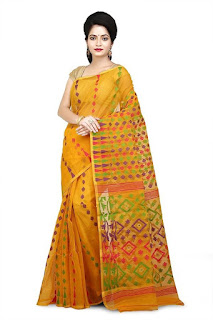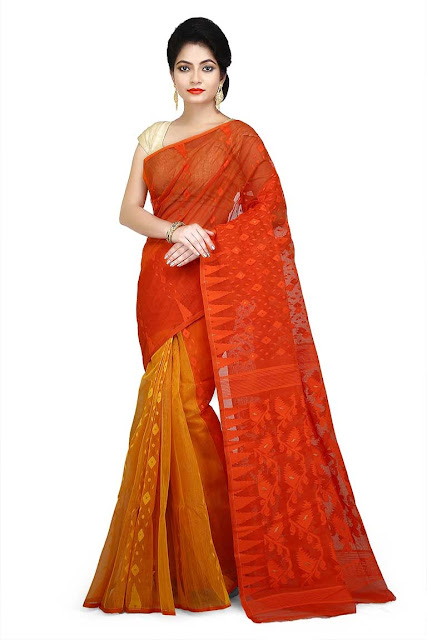Jamdani Saree Can Be A Piece Of Exquisite Collection For You
Jamdani
saree remains one of the most ancient forms and finest piece of weaving that
has been produced in Bengal. It originates in Bangladesh, and it is one of the
finest varieties of muslin hand-woven from cotton by the extraordinary
craftsmen. With a very lightweight like a feather, jamdani saree can be
available in brilliant designs with excellent floral motifs on the sarees. The
intricately designed motifs just seem to float on the thin surface of the
ultra-fine and transparent Jamdani saree that brings a mystical charm
unparallel with any other type of sarees.
Origin
of Jamdani Saree:
It is believed that the Jamdani saree
originated in Persia as the name Jamdani has been derived from Persian words,
where ‘Jam’ means flower and ‘Dani’ means vase. The finest variety of Jamdani
saree was produced during the Mughal rule during the 16th to 18th century and
it received wide patronage from the royal family. The trade continued to
flourish even after the decline of Mughal rule and during the British period,
the huge amount of Jamdani saree started to be exported to Europe.
Weaving
technique of Jamdani Saree:
The Jamdani Saree has been traditionally woven
in the brocade looms and a supplementary weft technique is used for producing
brilliant motifs. While the standard weft creates a very fine fabric, the
supplementary weft is used with thicker threads that add to the intricate
patterns. Each such supplementary weft motif is further added separately by
interlacing with the warp with the help of fine bamboo sticks. It results in
the production of a myriad of patterns that are extremely beautiful and vibrant
and appear to be floating on a shimmering surface.
The
most remarkable part of Jamdani weaving is that the pattern produced on the
saree is not outlined on the fabric or sketched. It is simply drawn on a graph
paper and it is placed underneath the warp to produce a brilliant effect. It
can be a real time-consuming process with a high degree of skill to produce a
Jamdani saree which may take even a year to complete. The process of producing
the Jamdani Saree can be very laborious too and the art of making such saree is
carried forward from generation to generation.
Different
types of Jamdani saree:
Different
types of Jamdani sarees are mainly classified depending on the type of motifs
or the region where these are produced. The popular motifs include kalka, panan
hazar, fulwar, butidar, jalar, tersa, charkona, duria, and many more. Here you
can find a list of the regional varieties of Jamdani sarees in the following
paragraphs.
Ø Tangail
Jamdani saree: It is woven in Tangail district and is famous for
its fine work with most elaborate workmanship.
Ø Shantipuri
Jamdani:
It is woven in Shantipur, in the state of West Bengal, and it is somewhat
similar to the Tangail jamdanis. It has also a fine texture, and often there
can be found elegant striped motifs.
Ø Dhaniakhali
Jamdani saree: This type of Jamdani saree has tighter weave compared
to other varieties and is marked by its bold colors and contrasting borders.
Ø Dhakai
Jamdani:
The original and the finest quality of Jamdani saree is the dhakai jamdanisaree that comes with most elaborate workmanship.



Comments
Post a Comment